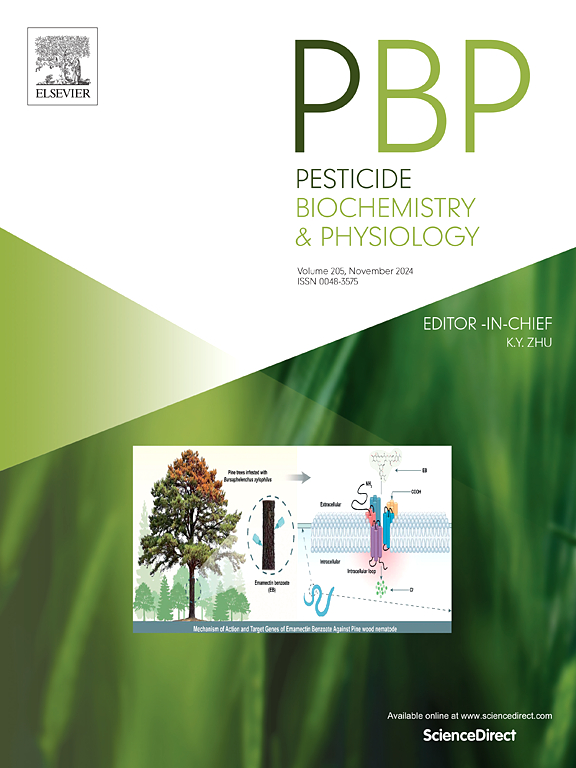Foliar application of selenium nanoparticles enhance quality and mitigate negative plant-soil feedback in Panax notoginseng by modulating plant-microbiota interactions
IF 4
1区 农林科学
Q2 BIOCHEMISTRY & MOLECULAR BIOLOGY
引用次数: 0
Abstract
Developing a practical strategy to enhance the quality of medicinal herb while alleviating negative plant-soil feedback (NPSF) is critical for agriculture. In this study, we investigated the effects of selenium nanoparticles (SeNPs) on Panax notoginseng through a two-year field experiment. Four treatments were established: a control (SeNPs_0) and three SeNPs concentrations (3, 5, and 10 mg/L), which were foliar-sprayed every 15 days for a total of six applications. We evaluated physiological characteristics, saponin accumulation, root rot incidence, and integrated metabolomics and microbiomics to elucidate the mechanisms of interaction between the aboveground and belowground parts of the plant. Results demonstrated that SeNPs significantly enhanced the total saponin content in the flowers (15.68% – 17.17 %), stems (11.44 % - 16.93 %), and roots (12.07 % - 17.34 %) of P. notoginseng. At a concentration of 5 mg/L, SeNPs significantly reduced root rot incidence by 71.43 % in Year 1 and 66.67 % in Year 2. Mechanistically, SeNPs activated flavonoid and terpenoid biosynthesis pathways, promoting saponin production (e.g., notoginsenoside Ft1 and Rb1). These metabolites enriched beneficial Trichoderma in the rhizosphere, which antagonized pathogens (Fusarium and Ilyonectria), thereby alleviating NPSF. Our study demonstrates that foliar application of SeNPs regulate plant-microbiota crosstalk, offering a dual-benefit solution for enhancing quality of medicinal component and controlling soil-borne diseases in perennial herbs.

叶面施用纳米硒通过调节植物-微生物群相互作用提高三七品质并减轻植物-土壤负反馈
制定切实可行的策略来提高药材质量,同时减轻植物-土壤负反馈(NPSF)对农业至关重要。本研究通过为期两年的田间试验,研究了纳米硒对三七的影响。建立了4个处理:对照(SeNPs_0)和3个SeNPs浓度(3、5和10 mg/L)处理,每15 d喷叶面,共6次。我们通过对其生理特性、皂苷积累、根腐病发生率、综合代谢组学和微生物学的研究来阐明地上部分和地下部分相互作用的机制。结果表明,SeNPs显著提高了三七花(15.68% ~ 17.17%)、茎(11.44% ~ 16.93%)和根(12.07% ~ 17.34%)总皂苷含量。在5 mg/L浓度下,SeNPs在第1年和第2年显著降低根腐病发生率,分别为71.43%和66.67%。从机制上讲,SeNPs激活了类黄酮和萜类生物合成途径,促进了皂苷的产生(例如三七皂苷Ft1和Rb1)。这些代谢物丰富了根际有益的木霉,可以拮抗病原菌(镰刀菌和赤霉病菌),从而缓解NPSF。本研究表明,SeNPs叶面施用可调节植物-微生物群的串扰,为多年生草本植物提高药用成分质量和防治土传病害提供了一种双赢的解决方案。
本文章由计算机程序翻译,如有差异,请以英文原文为准。
求助全文
约1分钟内获得全文
求助全文
来源期刊
CiteScore
7.00
自引率
8.50%
发文量
238
审稿时长
4.2 months
期刊介绍:
Pesticide Biochemistry and Physiology publishes original scientific articles pertaining to the mode of action of plant protection agents such as insecticides, fungicides, herbicides, and similar compounds, including nonlethal pest control agents, biosynthesis of pheromones, hormones, and plant resistance agents. Manuscripts may include a biochemical, physiological, or molecular study for an understanding of comparative toxicology or selective toxicity of both target and nontarget organisms. Particular interest will be given to studies on the molecular biology of pest control, toxicology, and pesticide resistance.
Research Areas Emphasized Include the Biochemistry and Physiology of:
• Comparative toxicity
• Mode of action
• Pathophysiology
• Plant growth regulators
• Resistance
• Other effects of pesticides on both parasites and hosts.

 求助内容:
求助内容: 应助结果提醒方式:
应助结果提醒方式:


